[Original works from the Stanley Kubrick Estate.
Stanley Kubrick and Geoffrey Unsworth developed a system for calculating from the grey tones of b/w Polaroids the right lighting for filming
2001: A SPACE ODYSSEY.]
Update
¬
Subscribe Newsletter
Newsletter no. 14, February 2005
Dear colleagues and friends:
After three very successful weeks of the Kubrick exhibition at the
¬ Martin-Gropius-Bau Berlin will stand
even more under the sign of the great director: due to the cooperation with the
¬ Berlin Film Festival
(Berlinale) and the
¬ Filmmuseum Berlin there will be a series of events and lectures and – most importantly –
yet another opportunity to see Kubrick's films in the theaters. The retrospective of the 55th International
Film Festival (10 through 20 February 2005) is devoted to the general theme production design and will present
various relating films. However, a special focus will be on Stanley Kubrick. His complete oeuvre is going to be
integrated into the respective categories of the program: "Interiors" (LOLITA, EYES WIDE SHUT), "Transit"
(THE KILLING), "Power" (SPARTACUS, DR. STRANGELOVE, FULL METAL JACKET), "Stage" (A CLOCKWORK ORANGE, BARRY LYNDON),
and "Labyrinths" (KILLER'S KISS, PATHS OF GLORY, THE SHINING). 2001: A SPACE ODYSSEY is shown as special screening in 70mm.
The accompanying exhibition Moving Spaces–Production Design and Film at the Filmmuseum Berlin will open the night
before the start of the Berlinale and will present, in cooperation with Deutsches Filmmuseum Frankfurt am Main,
some exhibits from the Kubrick Estate. Accordingly we are dedicating the current issue of the Kubrick newsletter
to the aspect of production design. Even though all components in Kubrick's films – from cinematography to montage
and music – are of equal importance, the director has always been said to have had a special relation to architecture
and set design. Kubrick and his production designers created worlds obsessed with detail and authenticity, yet at the
same time they were fantastic and visionary and as such have entered film history.
1. This Month's Object: the Dijnn chairs
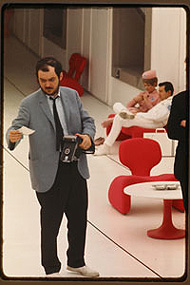
Kubrick undertook the probably most elaborate efforts regarding the film set with 2001: A SPACE ODYSSEY. Three
names are linked to its production design: Antony Masters, Harry Lange, and Ernest Archer. Moreover, in the four
year long production period Kubrick employed a sizeable art department and countless specialists. From scientists
and product developers of corporations he took advice as to how the world might look in 2001 (for comprehensive
accounts see two essays in our
¬ exhibition catalogue: "Designing the future" by Volker Fischer and "Branding 2001"
by Bernd Eichhorn). In the process elements of progressive contemporary design were adapted and projected into the
future. Excellent examples are the Djinn chairs. Today they constitute a still fashionable classic of design history.
The functional, yet playful series of chairs made of tubular steel covered with foam padding was designed in 1965 by
Olivier Mourgue and derives its name from servile ghosts in Arabic mythology who could take on human or animal shape.
In their softly curved, biomorphic forms the chairs are indeed reminiscent of live creatures and at the time they came
to represent a new futuristic look.
(Photo: Kubrick with his Polaroid on the set of 2001: A SPACE ODYSSEY)
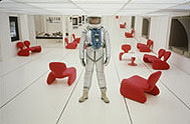
In 2001: A SPACE ODYSSEY they dominate the set in the lounge of Space Station Five where Dr. Floyd, on his way to the
moon, meets with several other space passengers. The original film props have not survived, but some collector's pieces
exist today. Thanks to a loan from the
¬ POPDOM Collection Siekmann in Cologne the Kubrick exhibition can present two
Djinn chairs (one of them a double seater). These chairs, which were originally covered with a green-brownish fabric,
were fitted with new covers especially for the exhibition. The choice of a new fabric presented a great challenge
because the original color varied strongly depending on the light. While in Kubrick's film the chairs appear almost
red, they actually had a slightly magenta tonality. The collector Dennis Gilliam, also a lender to the exhibition
area devoted to 2001: A SPACE ODYSSEY, reports on similar problems in the restoration of his chairs: see his
¬ website
with many images.
2. Brief portrait: Kubrick's production designer
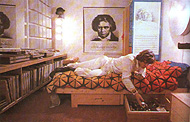
In the almost fifty years that Kubrick spent on making his films he hired many different people to be in charge of
production design. The set of his early film THE KILLING was designed by his first wife, the dancer Ruth Sobotka, who
frequented avant-garde art circles. For the following ten films Kubrick often changed his production designers,
sometimes working with them on one project only. Of prominence is his cooperation with John Barry, who was initially
engaged for the Napoleon project, but then took over A CLOCKWORK ORANGE. The designer who was later going to work on
STAR WARS (1977) and SUPERMAN (1978) (and who should not be confused with the famous film composer) was at that time
relatively unknown. For the adaptation of Burgess' novel Barry and Kubrick consulted volumes of architecture magazines.
Barry's shrill-bizarre interiors constitute a crucial element in the lasting effect of A CLOCKWORK ORANGE. After that
Kubrick worked on several projects with Roy Walker and Les Tomkins. Initially Walker collaborated as art director on
BARRY LYNDON and as production designer created the labyrinthine world of the hotel in THE SHINING. Les Tomkins was art
director on THE SHINING and FULL METAL JACKET and eventually took on, along with Walker, the production design for
Kubrick's last film, EYES WIDE SHUT.
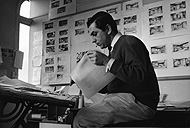
The probably most well-known and intensive collaboration developed between Kubrick and Ken Adam, whom we will look at
more closely now after various mentions in past newsletters. From the beginning he is linked to the Kubrick exhibition
(in 2002 within the context of the exhibition Visionary film worlds – Dr. Strangelove, Goldfinger, and other film sets
at Deutsches Filmmuseum in Frankfurt am Main curator Hans-Peter Reichmann met Christiane Kubrick and Jan Harlan who
attended the showing of DR. STRANGELOVE). The legendary British film architect, born Klaus Hugo Adam in Berlin in 1921,
had escaped the Nazis in 1934 at age thirteen and fled to London with his family. During WW II he served as the only
German born pilot in the Royal Air Force. At the Bartlett School he studied architecture. From his German background
he preserved his predilection for the Expressionism of the Weimar era. He started working in film initially as a
draftsman and Art Director for productions such as AROUND THE WORLD IN 80 DAYS (1956). As production designer her
achieved fame especially with his creations for seven Bond films, among them DR. NO (1962), GOLDFINGER (1964), THE
SPY WHO LOVED ME (1977), and MOONRAKER (1979).
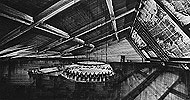
For Stanley Kubrick he created the grotesque topography of DR. STRANGELOVE OR: HOW I LEARNED TO STOP WORRYING AND
LOVE THE BOMB. Another collaboration came about with BARRY LYNDON, which was preceded by the most intense research
on the 18th century. For this film Adam received an Academy Award (a second in 1994 for THE MADNESS OF KING GEORGE,
another history film). In 2001 he was knighted by the Queen and since then is properly called "Sir Kenneth Adam".
With his wife Letizia he lives in London, but visits Berlin often and has been a frequent guest especially in recent
years at the Berlin Film Festival. At the first two Talent Campus events in 2003 and in 2004 he served as mentor and
this year because of the festival's theme production design he will of course be present (Ken Adam: Film Sets are Forever.
Haus der Kulturen der Welt, 14 February, 5p.m.). You can find another two essays on his production design in our
exhibition catalogue: Boris Hars-Tschachotin's text on "Superpower paranoia expressed in space" dealing with the
design of the War Room and an interview with Ken Adam about DR. STRANGELOVE and BARRY LYNDON, excerpts of which you
may read on our website.
(Photo: Sketch for the war room, © Ken Adam)
3. Dates and places around the Berlin Film Festival
We would like to provide you with a brief synopsis of the film and event program on Stanley Kubrick. We have also
compiled all relevant dates and addresses in a
¬ pdf-file.
The exhibition Stanley Kubrick at the
¬ Martin-Gropius-Bau has special and extended opening
hours during the Berlinale
and will remain open daily from 10a.m. through 9p.m. At 5p.m. every day there will be showing of Jan Harlan's
STANLEY KUBRICK: A LIFE IN PICTURES at the MGB's movie theater.
Kubrick's films can be seen during the
¬ Berlinale from 10 through 20 February at CinemaxX and at the Zeughauskino.
A showing of 2001: A SPACE ODYSSEY will take place at the Urania. After the Festival closes the Zeughauskino will
show all films again through 6 March and will also show Jan Harlan's STANLEY KUBRICK: A LIFE IN PICTURES.
The exhibition Moving Spaces–Production Design and Film at the
¬ Filmmuseum Berlin will open on 9 February at 7p.m.
and will be on through 19 June.
We would like to recommend to you two events albeit they are overlapping: On 16 February at the
¬ Urania at 5:30p.m.
our catalogue contributors Eva-Maria Magel and Ronny Loewy are going to present two projects of Kubrick's that were
never realized, "Aryan Papers" and "Napoleon". At another event titled "Stanley Kubrick: Creating a World" Christiane
Kubrick and Jan Harlan are going to meet French film critic Michel Ciment at the
¬ Filmmuseum Berlin at 6.p.m. Ciment
already attended last year's Kubrick symposium at the Deutsche Filmmuseum in Frankfurt am Main.
Three weeks after the Berlin Film Festival, on 5 March from 2 through 6p.m., the workshop "Moving Spaces–Aspects of
the Labyrinthine" will take place in connection with the two exhibitions and in cooperation with the
¬ Einstein Forum.
Participants are going to be, among others, Jan Harlan, set designer Alex McDowell, and the theater studies expert
Hans-Thies Lehmann (see his exhibition catalogue essay on EYES WIDE SHUT).
We are pleased to announce a media-cooperation: The Berlin
¬ Yorck movie theaters will present, in the course of the
next weeks, in several important theaters (International, Filmtheater am Friedrichshain, Capitol Dahlem, Yorck New
Yorck, Babylon, and Odeon) a trailer for the Kubrick exhibition produced by Bibo TV.
On the day before the start of the Berlin Film Festival German TV star Anke Engelke will report live from the Kubrick
exhibition in
¬ ARD Morgenmagazin. Between 11 and 18 February some of Kubrick's films are
going to be aired on
¬ RBB and
¬ 3sat;
¬ ZDF will air 2001: A SPACE ODYSSEY on 5 March.
¬ drucken
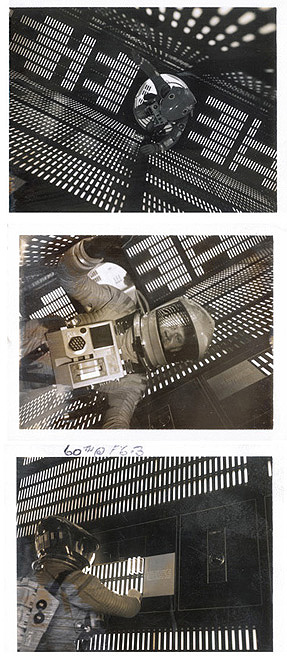

 Kubrick undertook the probably most elaborate efforts regarding the film set with 2001: A SPACE ODYSSEY. Three
names are linked to its production design: Antony Masters, Harry Lange, and Ernest Archer. Moreover, in the four
year long production period Kubrick employed a sizeable art department and countless specialists. From scientists
and product developers of corporations he took advice as to how the world might look in 2001 (for comprehensive
accounts see two essays in our ¬ exhibition catalogue: "Designing the future" by Volker Fischer and "Branding 2001"
by Bernd Eichhorn). In the process elements of progressive contemporary design were adapted and projected into the
future. Excellent examples are the Djinn chairs. Today they constitute a still fashionable classic of design history.
The functional, yet playful series of chairs made of tubular steel covered with foam padding was designed in 1965 by
Olivier Mourgue and derives its name from servile ghosts in Arabic mythology who could take on human or animal shape.
In their softly curved, biomorphic forms the chairs are indeed reminiscent of live creatures and at the time they came
to represent a new futuristic look.
Kubrick undertook the probably most elaborate efforts regarding the film set with 2001: A SPACE ODYSSEY. Three
names are linked to its production design: Antony Masters, Harry Lange, and Ernest Archer. Moreover, in the four
year long production period Kubrick employed a sizeable art department and countless specialists. From scientists
and product developers of corporations he took advice as to how the world might look in 2001 (for comprehensive
accounts see two essays in our ¬ exhibition catalogue: "Designing the future" by Volker Fischer and "Branding 2001"
by Bernd Eichhorn). In the process elements of progressive contemporary design were adapted and projected into the
future. Excellent examples are the Djinn chairs. Today they constitute a still fashionable classic of design history.
The functional, yet playful series of chairs made of tubular steel covered with foam padding was designed in 1965 by
Olivier Mourgue and derives its name from servile ghosts in Arabic mythology who could take on human or animal shape.
In their softly curved, biomorphic forms the chairs are indeed reminiscent of live creatures and at the time they came
to represent a new futuristic look.
 In 2001: A SPACE ODYSSEY they dominate the set in the lounge of Space Station Five where Dr. Floyd, on his way to the
moon, meets with several other space passengers. The original film props have not survived, but some collector's pieces
exist today. Thanks to a loan from the ¬ POPDOM Collection Siekmann in Cologne the Kubrick exhibition can present two
Djinn chairs (one of them a double seater). These chairs, which were originally covered with a green-brownish fabric,
were fitted with new covers especially for the exhibition. The choice of a new fabric presented a great challenge
because the original color varied strongly depending on the light. While in Kubrick's film the chairs appear almost
red, they actually had a slightly magenta tonality. The collector Dennis Gilliam, also a lender to the exhibition
area devoted to 2001: A SPACE ODYSSEY, reports on similar problems in the restoration of his chairs: see his ¬ website
with many images.
In 2001: A SPACE ODYSSEY they dominate the set in the lounge of Space Station Five where Dr. Floyd, on his way to the
moon, meets with several other space passengers. The original film props have not survived, but some collector's pieces
exist today. Thanks to a loan from the ¬ POPDOM Collection Siekmann in Cologne the Kubrick exhibition can present two
Djinn chairs (one of them a double seater). These chairs, which were originally covered with a green-brownish fabric,
were fitted with new covers especially for the exhibition. The choice of a new fabric presented a great challenge
because the original color varied strongly depending on the light. While in Kubrick's film the chairs appear almost
red, they actually had a slightly magenta tonality. The collector Dennis Gilliam, also a lender to the exhibition
area devoted to 2001: A SPACE ODYSSEY, reports on similar problems in the restoration of his chairs: see his ¬ website
with many images.  In the almost fifty years that Kubrick spent on making his films he hired many different people to be in charge of
production design. The set of his early film THE KILLING was designed by his first wife, the dancer Ruth Sobotka, who
frequented avant-garde art circles. For the following ten films Kubrick often changed his production designers,
sometimes working with them on one project only. Of prominence is his cooperation with John Barry, who was initially
engaged for the Napoleon project, but then took over A CLOCKWORK ORANGE. The designer who was later going to work on
STAR WARS (1977) and SUPERMAN (1978) (and who should not be confused with the famous film composer) was at that time
relatively unknown. For the adaptation of Burgess' novel Barry and Kubrick consulted volumes of architecture magazines.
Barry's shrill-bizarre interiors constitute a crucial element in the lasting effect of A CLOCKWORK ORANGE. After that
Kubrick worked on several projects with Roy Walker and Les Tomkins. Initially Walker collaborated as art director on
BARRY LYNDON and as production designer created the labyrinthine world of the hotel in THE SHINING. Les Tomkins was art
director on THE SHINING and FULL METAL JACKET and eventually took on, along with Walker, the production design for
Kubrick's last film, EYES WIDE SHUT.
In the almost fifty years that Kubrick spent on making his films he hired many different people to be in charge of
production design. The set of his early film THE KILLING was designed by his first wife, the dancer Ruth Sobotka, who
frequented avant-garde art circles. For the following ten films Kubrick often changed his production designers,
sometimes working with them on one project only. Of prominence is his cooperation with John Barry, who was initially
engaged for the Napoleon project, but then took over A CLOCKWORK ORANGE. The designer who was later going to work on
STAR WARS (1977) and SUPERMAN (1978) (and who should not be confused with the famous film composer) was at that time
relatively unknown. For the adaptation of Burgess' novel Barry and Kubrick consulted volumes of architecture magazines.
Barry's shrill-bizarre interiors constitute a crucial element in the lasting effect of A CLOCKWORK ORANGE. After that
Kubrick worked on several projects with Roy Walker and Les Tomkins. Initially Walker collaborated as art director on
BARRY LYNDON and as production designer created the labyrinthine world of the hotel in THE SHINING. Les Tomkins was art
director on THE SHINING and FULL METAL JACKET and eventually took on, along with Walker, the production design for
Kubrick's last film, EYES WIDE SHUT.  The probably most well-known and intensive collaboration developed between Kubrick and Ken Adam, whom we will look at
more closely now after various mentions in past newsletters. From the beginning he is linked to the Kubrick exhibition
(in 2002 within the context of the exhibition Visionary film worlds – Dr. Strangelove, Goldfinger, and other film sets
at Deutsches Filmmuseum in Frankfurt am Main curator Hans-Peter Reichmann met Christiane Kubrick and Jan Harlan who
attended the showing of DR. STRANGELOVE). The legendary British film architect, born Klaus Hugo Adam in Berlin in 1921,
had escaped the Nazis in 1934 at age thirteen and fled to London with his family. During WW II he served as the only
German born pilot in the Royal Air Force. At the Bartlett School he studied architecture. From his German background
he preserved his predilection for the Expressionism of the Weimar era. He started working in film initially as a
draftsman and Art Director for productions such as AROUND THE WORLD IN 80 DAYS (1956). As production designer her
achieved fame especially with his creations for seven Bond films, among them DR. NO (1962), GOLDFINGER (1964), THE
SPY WHO LOVED ME (1977), and MOONRAKER (1979).
The probably most well-known and intensive collaboration developed between Kubrick and Ken Adam, whom we will look at
more closely now after various mentions in past newsletters. From the beginning he is linked to the Kubrick exhibition
(in 2002 within the context of the exhibition Visionary film worlds – Dr. Strangelove, Goldfinger, and other film sets
at Deutsches Filmmuseum in Frankfurt am Main curator Hans-Peter Reichmann met Christiane Kubrick and Jan Harlan who
attended the showing of DR. STRANGELOVE). The legendary British film architect, born Klaus Hugo Adam in Berlin in 1921,
had escaped the Nazis in 1934 at age thirteen and fled to London with his family. During WW II he served as the only
German born pilot in the Royal Air Force. At the Bartlett School he studied architecture. From his German background
he preserved his predilection for the Expressionism of the Weimar era. He started working in film initially as a
draftsman and Art Director for productions such as AROUND THE WORLD IN 80 DAYS (1956). As production designer her
achieved fame especially with his creations for seven Bond films, among them DR. NO (1962), GOLDFINGER (1964), THE
SPY WHO LOVED ME (1977), and MOONRAKER (1979).
 For Stanley Kubrick he created the grotesque topography of DR. STRANGELOVE OR: HOW I LEARNED TO STOP WORRYING AND
LOVE THE BOMB. Another collaboration came about with BARRY LYNDON, which was preceded by the most intense research
on the 18th century. For this film Adam received an Academy Award (a second in 1994 for THE MADNESS OF KING GEORGE,
another history film). In 2001 he was knighted by the Queen and since then is properly called "Sir Kenneth Adam".
With his wife Letizia he lives in London, but visits Berlin often and has been a frequent guest especially in recent
years at the Berlin Film Festival. At the first two Talent Campus events in 2003 and in 2004 he served as mentor and
this year because of the festival's theme production design he will of course be present (Ken Adam: Film Sets are Forever.
Haus der Kulturen der Welt, 14 February, 5p.m.). You can find another two essays on his production design in our
exhibition catalogue: Boris Hars-Tschachotin's text on "Superpower paranoia expressed in space" dealing with the
design of the War Room and an interview with Ken Adam about DR. STRANGELOVE and BARRY LYNDON, excerpts of which you
may read on our website.
For Stanley Kubrick he created the grotesque topography of DR. STRANGELOVE OR: HOW I LEARNED TO STOP WORRYING AND
LOVE THE BOMB. Another collaboration came about with BARRY LYNDON, which was preceded by the most intense research
on the 18th century. For this film Adam received an Academy Award (a second in 1994 for THE MADNESS OF KING GEORGE,
another history film). In 2001 he was knighted by the Queen and since then is properly called "Sir Kenneth Adam".
With his wife Letizia he lives in London, but visits Berlin often and has been a frequent guest especially in recent
years at the Berlin Film Festival. At the first two Talent Campus events in 2003 and in 2004 he served as mentor and
this year because of the festival's theme production design he will of course be present (Ken Adam: Film Sets are Forever.
Haus der Kulturen der Welt, 14 February, 5p.m.). You can find another two essays on his production design in our
exhibition catalogue: Boris Hars-Tschachotin's text on "Superpower paranoia expressed in space" dealing with the
design of the War Room and an interview with Ken Adam about DR. STRANGELOVE and BARRY LYNDON, excerpts of which you
may read on our website.